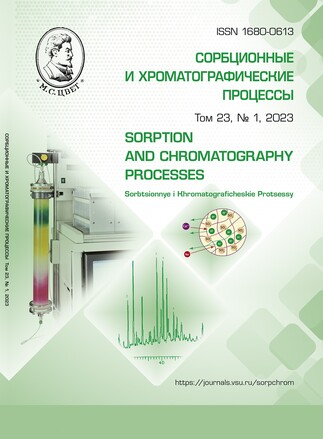Isolation and purification method of low molecular weight peptides from bee products using chromatographic methods
Abstract
The study of the biological activity of various peptide substances is one of the modern research areas of biochemistry. Over the past few decades, a large number of reports in the scientific literature about the presence of a certain effect of bee products on various biological systems were published, while the number of peptides revealed in royal jelly and drone brood is increasing every year. This resulted in the need to develop a convenient and productive method for the isolation and purification of the peptide fraction from bee products, which was the goal of this study. As a result, the method for isolation of the fraction of low molecular weight peptides (with the molecular weight less than 5 kDa) from royal jelly and drone brood was developed and tested. This method includes ultrafiltration for the separation of the solution molecules according to the molecular weight parameter, ion-exchange chromatography on DEAE-cellulose for purification of peptides from low molecular weight impurities and gel filtration on Sephadex G-25 for the removal salts of buffer solutions. The proposed method for the isolation and purification of peptides can be easily scaled and automated, which allows the use of the proposed method under industrial conditions. The control of the peptide composition in comparison of the original filtrate and the purified fraction was carried out using high performance liquid chromatography. As a result of using this method, an acceptable degree of purification is achieved, and the purified peptides were obtained in an aqueous solution suitable both for further assessment of biological activity and for the investigation of the composition by various physicochemical methods. Initial data on the physicochemical properties of purified peptides were also obtained: Five out of nine groups of royal jelly peptides and four out of eleven groups of peptides in the composition of drone brood contained amino acids with aromatic radicals; at pH=10, majority of royal jelly peptides were anionic, and majority of drone brood peptides were cationic.
Downloads
References
Nagai T., Inoue R. Preparation and the functional properties of water extract and alkaline extract of royal jelly. Food Chemistry. 2004; 84; 181–186.
Cianciosi D., Yuliett Forbes-Hernández T., Afrin S., Gasparrini M., Reboredo-Rodriguez P., Pia Manna P., Zhang J., Bravo Lamas L., Martínez Flórez S., Agudo Toyos P., Quiles J. L., Giampieri F., Battino M. Phenolic Compounds in Honey and Their Associated Health Benefits: A Review. Molecules. 2018; 23(9): 2322.
Chan-Zapata I., Segura-Campos M. R. Honey and its protein components: Effects in the cancer immunology. Journal of Food Biochemistry. 2021; 45(5): e13613.
Leiva-Sabadini C., Alvarez S., P Bar-rera N., M. A. P. Schuh C., Sebastian Aguayo. Antibacterial Effect of Honey-Derived Exosomes Containing Antimicrobial Peptides Against Oral Streptococci. International Journal of Nanomedicine. 2021; 16: 4891-4900.
Bílikova K., Huang S.-C., Lin, I.-P., Šimuth J., Peng C.-C. Structure and anti-microbial activity relationship of royalisin, an antimicrobial peptide from royal jelly of Apis mellifera. Peptides. 2015; 68; 190-196.
Nagai T., Inoue R., Suzuki N., Nagashima T. Antioxidant properties of enzymatic hydrolysates from royal jelly. Journal of Medicinal Food. 2006; 9(3); 363-367.
Zhang X., Yu Y., Fan Z., Zhang W., Feng C. Royal jelly peptides: potential inhibitors of β-secretase in N2a/APP695swe cells. Scientific Reports. 2019; 9: 168.
Minegaki N., Koshizuka T., Nishina S., Kondo H., Takahashi K., Sugiyama T., Inoue I. The Carboxyl-Terminal Penta-Peptide Repeats of Major Royal Jelly Pro-tein 3 Enhance Cell Proliferation. Biological and Pharmaceutical Bulletin. 2020; 43(12): 1911-1916.
Patent № 2287334 C2 Russian Feder-ation, МПК A61K 35/64, A61P 21/06, A61P 25/00. Drone brood substances with anabolic and actoprotective effects: № 2002118584/15: submitted. 09.07.2002: publised. 20.11.2006 / Lazaryan D. S., Sot-nikova E. M.; applicant Pyatigorsk State Pharmaceutical Academy. (In Russ.)
Katsumi Matsuzaki. Antimicrobial Peptides. Springer Singapore. 2019, 304 p.
Apostolopoulos V, Bojarska J., Chai T.-T., Elnagdy S., Kaczmarek K., Matsou-kas J., New R., Parang K., Paredes Lopez O., Parhiz H., Perera C. O., Pickholz M., Remko M., Saviano M., Skwarczynski M., Tang Y., Wolf W. M., Yoshiya T., Zabrocki J., Zielenkiewicz P., AlKhazindar M., Barriga V., Kelaidonis K., Mousavinezhad Sarasia E., Toth I. A Global Re-view on Short Peptides: Frontiers and Perspectives. Molecules. 2021; 2(26): 430.
Lowry O.H., Rosebrought N.J., Farr A.G., Randall R.J. Protein measurement with the Folin phenol reagent. J. Biol. Chem. 1951; 193(1); 265-275.
Noble J.E., Bailey M.J.A. Quantitation of protein. Methods in Enzymology. 2009; 463: 73-95.







